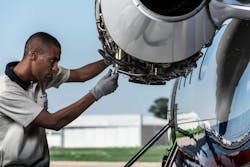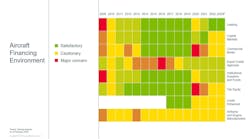World passenger traffic is expected to maintain 4.5 percent annual growth over the next two decades, according to Embraer’s 2017 20-year aircraft forecast. And according to the Regional Airline Association, regional airlines operate 44 percent of our nation’s scheduled commercial airline departures.
To keep aircraft flying and regional airlines in operation, MROs are also expected to grow, and to benefit from the market change, aircraft manufacturers are growing their MRO businesses.
As one of the world’s largest manufacturers of commercial jets, with a global fleet of 1,300 E-Jets, operated by 70 airlines in 50 countries, Embraer is looking to expand its business in the MRO market.
Last December Embraer announced it was creating a new business unit dedicated to services and support. Embraer has been manufacturing aircraft since 1969. AMT talked to Johann Bordais, president and CEO of the new unit, Embraer Services & Support. His previous role was director of services and support for Embraer Commercial Aviation.
Combining Support Services
Embraer has traditionally had services and support operations under each of its divisions: commercial aviation, business aviation, and defense and security.
“For the customer, this initiative combines a long experience in customer service, with the agility and competitiveness of a service center. For Embraer, it represents an opportunity to obtain greater operational efficiency and recurring revenues," Bordais says.
From an internal perspective Embraer’s goal is to implement best practices across all three aircraft divisions by combining support services for each aircraft division instead of tripling service requirements. With all three business units there are over 2,200 support people to implement the plan.
The company has set a target of increasing MRO services from 15 to 25 percent in four years. From an external perspective, Bordais wants to ensure customers don’t notice a change with current relationships or the level of service. “Customer service is part of the Brazilian DNA,” he says. “The customers contact the same people; we don’t want to affect customer relationships. We’ll just add support behind the scenes.”
Embraer currently has 10 approved service centers for commercial aviation and 70 owned and authorized service centers for business aviation. Locations include Nashville, TN; Melbourne, FL; Dublin, Ireland; Dubai; Le Bourget, France; Amsterdam, Netherlands; Farnborough, UK; Warsaw, Poland; Evora and Alverca, Portugal; Sao Jose dos Campos and Porto Alegre, Brazil; Buenos Aires, Argentina; Nairobi, Kenya; Tianjin and Jinan, China; Singapore; and Clark, Philippines.
Partners and Competitors
As Bordais states, current competitors are also partners. Embraer wants to be an agnostic MRO, maintaining other aircraft brands in addition to its own. Currently, for Commercial Aviation maintenance, it partners with TAP Maintenance & Engineering, Austral, Tianjin, STAECO, OGMA, Embraer Aircraft Maintenance Services, LOTAMS, Kenya Airways, and Hawker Pacific Asia.
Embraer has also appointed SIA Engineering (Philippines) Corporation (SIAEP) as an E-Jets authorized service center. “The appointment of SIAEP as an authorized E-Jets service center in the region is a result of our commitment to enhance our services and support solutions to E-Jets operators in Asia Pacific,” says Bordais.
Bordais also mentioned growth plans for Africa as the number of aircraft is projected to increase in that area as well.
“There is a change in the marketplace,” Bordais says. “What’s needed is not just aircraft but customer support. You have to admit to problems, find solutions, and keep customers satisfied.”
Sidebar: Aircraft Forecast
According to Embraer’s 2017 aircraft forecast, world passenger traffic is expected to maintain 4.5 percent annual growth over the next two decades. By 2036, the Middle East and Asia Pacific will be the fastest growing markets, with an annual revenue passenger kilometers (RPK) growth rate of around 6.0 percent, followed by Latin America with 5.2 percent, Africa with 4.9 percent, the Commonwealth of Independent States (CIS) with 3.6 percent, Europe also with 3.6 percent, and North America with 2.7 percent.
World air transport demand will increase 2.5 times by 2036, reaching 16 trillion RPKs for all commercial aircraft segments.
Asia Pacific will be the largest market, accounting for 37% of world RPKs. Combined, Europe and North America will generate 36 percent of total air transport demand.
Embraer foresees world demand for 6,400 new jets in the 70- to 130-seat segment over the next 20 years — 2,280 units in the 70- to 90-seat segment and 4,120 units in the 90- to 130-seat segment — representing a total market value of US$300 billion. The 70 to 130-seat jet world fleet will increase from 2,700 aircraft in 2016 to 6,710 by 2036, the fastest growing segment among all aircraft categories. Replacement of aging aircraft will represent 37 percent of new deliveries and 63 percent will represent market growth.
2017 to 2036: 70- to 90-seat Aircraft (Projected Deliveries)
North America 1,220
Asia-Pacific 510
Europe 270
CIS 100
Latin America 70
Middle East 50
Africa 60
2017 to 2036: 90- to 130-seat Aircraft (Projected Deliveries)
Asia Pacific 1,200
Europe 880
North America 800
Latin America 620
CIS 290
Middle East 170
Africa 160
For more information on the forecast visit www.embraermarketoutlook2017.com.


